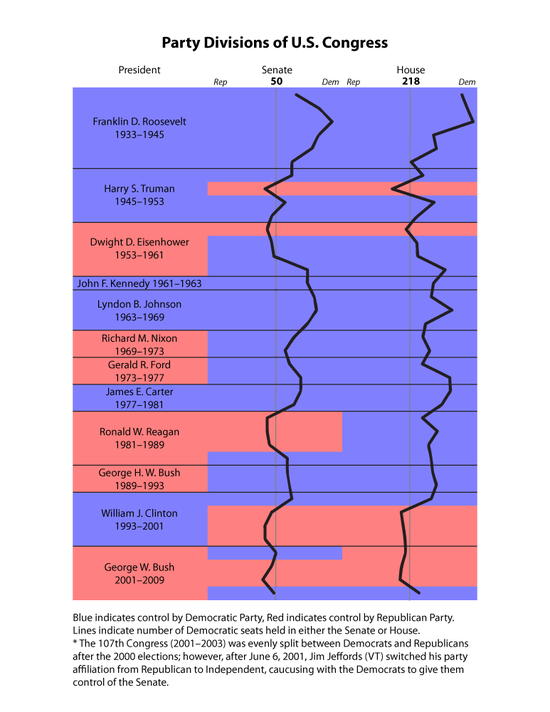Divided government in the United States
In the United States, divided government describes a situation in which one party controls the executive branch while another party controls one or both houses of the legislative branch.
Divided government is seen by different groups as a benefit or as an undesirable product of the model of governance used in the U.S. political system. Under said model, known as the separation of powers, the state is divided into different branches. Each branch has separate and independent powers and areas of responsibility so that the powers of one branch are not in conflict with the powers associated with the others. The model can be contrasted with the fusion of powers in a parliamentary system where the executive and legislature (and sometimes parts of the judiciary) are unified. Those in favor of divided government believe that such separations encourage more policing of those in power by the opposition, as well as limiting spending and the expansion of undesirable laws.[1] Opponents, however, argue that divided governments become lethargic, leading to many gridlocks. In the late 1980s, Terry M. Moe, a professor of political science at Stanford University, examined the issue.[2] He concluded that divided governments lead to compromise which can be seen as beneficial. But he also noticed that divided governments subvert performance and politicize the decisions of executive agencies.
Early in the 20th century, divided government was rare, but since the 1970s it has become increasingly common.
Party control of legislative and executive branches since 1901

D denotes the Democratic Party and R denotes the Republican Party
| Year | President | Senate | House |
|---|---|---|---|
| 1901–1903 | R | R | R |
| 1903–1905 | R | R | R |
| 1905–1907 | R | R | R |
| 1907–1909 | R | R | R |
| 1909–1911 | R | R | R |
| 1911-1913 | R | R | D |
| 1913–1915 | D | D | D |
| 1915–1917 | D | D | D |
| 1917–1919 | D | D | D |
| 1919-1921 | D | R | R |
| 1921–1923 | R | R | R |
| 1923–1925 | R | R | R |
| 1925–1927 | R | R | R |
| 1927–1929 | R | R | R |
| 1929–1931 | R | R | R |
| 1931-1933 | R | R | D |
| 1933–1935 | D | D | D |
| 1935–1937 | D | D | D |
| 1937–1939 | D | D | D |
| 1939–1941 | D | D | D |
| 1941–1943 | D | D | D |
| 1943–1945 | D | D | D |
| 1945–1947 | D | D | D |
| 1947-1949 | D | R | R |
| 1949–1951 | D | D | D |
| 1951–1953 | D | D | D |
| 1953–1955 | R | R | R |
| 1955-1957 | R | D | D |
| 1957-1959 | R | D | D |
| 1959-1961 | R | D | D |
| 1961–1963 | D | D | D |
| 1963–1965 | D | D | D |
| 1965–1967 | D | D | D |
| 1967–1969 | D | D | D |
| 1969-1971 | R | D | D |
| 1971-1973 | R | D | D |
| 1973-1975 | R | D | D |
| 1975-1977 | R | D | D |
| 1977–1979 | D | D | D |
| 1979–1981 | D | D | D |
| 1981-1983 | R | R | D |
| 1983-1985 | R | R | D |
| 1985-1987 | R | R | D |
| 1987-1989 | R | D | D |
| 1989-1991 | R | D | D |
| 1991-1993 | R | D | D |
| 1993–1995 | D | D | D |
| 1995-1997 | D | R | R |
| 1997-1999 | D | R | R |
| 1999-2001 | D | R | R |
| 2001-2003 | R | D* | R |
| 2003–2005 | R | R | R |
| 2005–2007 | R | R | R |
| 2007-2009 | R | D | D |
| 2009–2011 | D | D | D |
| 2011-2013 | D | D | R |
| 2013-2015 | D | D | R |
| 2015-2017 | D | R | R |
| 2017-2019 | R | R | R |
*The 2000 election resulted in a 50-50 tie in the Senate, and the Constitution gives tie-breaking power to the Vice President. The Vice President was Democrat Al Gore from January 3, 2001 until the inauguration of Republican Richard Cheney on January 20. Then on May 24, Republican Senator Jim Jeffords of Vermont left the Republican Party to caucus with the Democrats as an independent, resulting in another shift of control.
See also
References
- ↑ "Would Divided Government Be Better?". Cato Institute. Retrieved 20 September 2015.
- ↑ Moe, Terry (1989). "The Politics of Bureaucratic Structure". Retrieved 2016-05-04.
Further reading
- Morris Fiorina, Divided Government, 1996.
- David R. Mayhew, Divided We Govern, 1991.